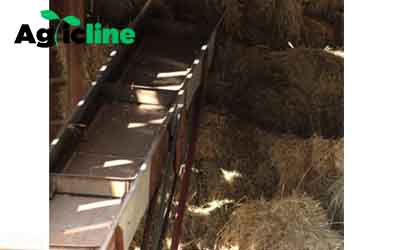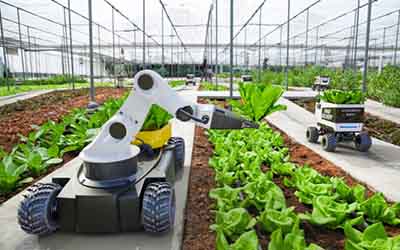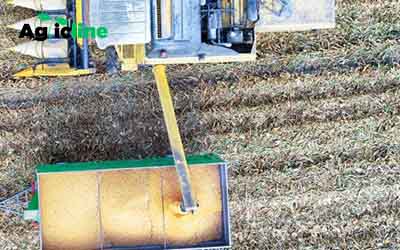A hay elevator, also known as a hay conveyor or hay lift, is a type of agricultural equipment used to transport hay or other types of baled or loose materials vertically or horizontally. It is particularly useful for moving hay from ground level to elevated storage areas such as lofts or barns.
The basic design of a hay elevator consists of a series of metal or wooden slats connected by chains or belts that form a continuous loop.
One end of the elevator is usually positioned on the ground or at a lower level, while the other end reaches the desired height. The slats or buckets on the elevator carry the hay as they move along the loop, allowing it to be lifted or transported.
Hay elevators are typically powered by an electric motor or a tractor’s power take-off (PTO) system. The motor or PTO drives a pulley system that moves the chains or belts, causing the slats to rotate and lift the hay. Some models also have adjustable speed settings to control the rate of elevation or horizontal movement.
Using a hay elevator can significantly reduce manual labor and streamline the process of handling and storing hay. It eliminates the need for physically lifting and carrying bales up a ladder or staircase, making it more efficient and safer.
It’s worth noting that while hay elevators are commonly used in agricultural settings, they can also have applications in other industries where the vertical or horizontal transport of materials is required.
Types of Hay Elevator
There are several types of hay elevators available, each with its own features and capabilities.
Portable Hay Elevator
This type of hay elevator is designed to be easily transported and set up in different locations. It is often lightweight, with collapsible or detachable components, making it convenient for farmers who need to move the elevator between fields or barns.
Stationary
A stationary hay elevator is permanently installed in a specific location, such as a barn or storage facility. It is typically more robust and sturdy than portable models and is designed for long-term use.
Vertical
A vertical hay elevator is used to lift hay or other materials from a lower level to a higher level, such as a loft or storage area. It is equipped with a vertical conveyor system that allows for efficient vertical movement.
Incline Elevator
An incline hay elevator is used to transport hay or other materials at an inclined angle. It is often used when there is a need to move hay from ground level to a higher elevation with a slope or incline.
Belt Conveyor Hay Elevator
This type of hay elevator uses a continuous belt with cleats or buckets to transport the hay. The belt is driven by an electric motor or a tractor’s PTO system, and it can be adjusted to control the speed and direction of movement.
Chain Conveyor
A chain conveyor hay elevator utilizes a series of metal slats or buckets connected by chains to transport hay. It operates similarly to a belt conveyor but uses chains instead of a continuous belt.
General functions
- Lifting Hay: The primary function of a hay elevator is to lift hay from ground level to an elevated storage area such as a loft or barn. It eliminates the need for manual lifting and carrying of heavy bales up ladders or staircases, reducing physical labor and potential injuries.
- Transporting Hay: A hay elevator can also transport hay horizontally, allowing for efficient movement of bales within a barn or storage facility. This function helps in organizing and arranging the hay for easy access and optimal use of space.
- Loading and Unloading: Hay elevators facilitate the loading and unloading of hay onto trucks, trailers, or other storage platforms. This function is particularly useful when transferring hay between different locations or transporting it for sale or distribution.
- Storage Optimization: By lifting hay to elevated storage areas such as lofts, hay elevators help optimize storage space within a barn or facility. This ensures that the hay is stored in a manner that minimizes the risk of spoilage, mold, or damage from moisture or pests.
- Versatility: While primarily designed for handling hay, hay elevators can also be used to transport other types of baled or loose materials, such as straw, grain bags, or other agricultural products. Their versatility makes them a useful tool in various farming and agricultural operations.
- Time and Labor Savings: By automating the process of lifting and transporting hay, hay elevators save significant time and labor. They increase operational efficiency, allowing farmers to handle larger volumes of hay in less time and with fewer physical exertions.
- Safety: Hay elevators enhance safety by minimizing the risk of accidents or injuries associated with manual handling of heavy bales. They provide a controlled and consistent method of lifting and moving hay, reducing the strain on workers and promoting workplace safety.
Maintenance
To ensure the proper functioning and longevity of elevator, regular maintenance is essential.
- Regularly clean elevator to remove any debris, dust, or hay residue that may accumulate on the conveyor system, pulleys, or other components.
- Keep the moving parts of the hay elevator well-lubricated to minimize friction and wear. Apply lubricants such as oil or grease to the chains, bearings, pulleys, and other rotating components as per the manufacturer’s recommendations.
- Perform routine inspections of the elevator to identify any signs of damage, wear, or misalignment. Check the belts, chains, slats, and fasteners for signs of wear, and replace any worn or damaged parts promptly.
- Check and adjust the tension of the belts or chains as necessary. Proper tension is crucial for smooth and efficient operation. Refer to the manufacturer’s guidelines for the appropriate tension specifications and adjustment procedures.
- Motor and Power Transmission: If the elevator is powered by an electric motor or tractor PTO, inspect and maintain the motor or PTO system according to the manufacturer’s instructions. Check for proper alignment, belt tension, and any signs of wear or damage. Ensure that the power transmission system is functioning correctly.
- When not in use, store it in a clean, dry location to prevent rust, corrosion, or damage from environmental elements. Cover or protect the equipment to shield it from dust, moisture, and sunlight.
Online stores to get Hay Elevator
Here are the top online stores where you can get quality hay elevators;
- Tractor Supply Co. (www.tractorsupply.com)
- Agri Supply (www.agrisupply.com)
- Rural King (www.ruralking.com)
- eBay (www.ebay.com)
- Amazon (www.amazon.com)
- FarmTek (www.farmtek.com)
- Northern Tool (www.northerntool.com)
- Hayneedle (www.hayneedle.com)
- Farm & Home Supply (www.farmandhomesupply.com)
- Equipment Trader (www.equipmenttrader.com)
It is important to note that availability, pricing, and shipping options may vary among these platforms. It’s recommended to compare prices, read customer reviews, and check the shipping policies before making a purchase.



